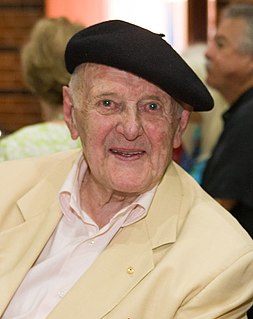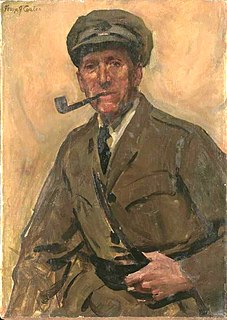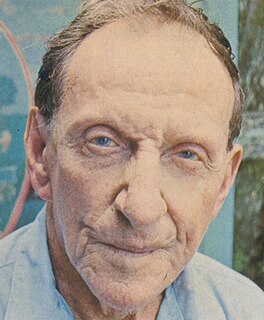
Thomas William Roberts was an English-born Australian artist and a key member of the Heidelberg School art movement, also known as Australian impressionism.

The Fool were a Dutch design collective and band in the psychedelic style of art in British popular music in the late 1960s. The group was named in reference to the Fool tarot card.

Psychedelic art is art, graphics or visual displays related to or inspired by psychedelic experiences and hallucinations known to follow the ingestion of psychedelic drugs such as LSD and psilocybin. The word "psychedelic" means "mind manifesting". By that definition, all artistic efforts to depict the inner world of the psyche may be considered "psychedelic".

Grace Cossington Smith was an Australian artist and pioneer of modernist painting in Australia and was instrumental in introducing Post-Impressionism to her home country. Examples of her work are held by every major gallery in Australia.

John Henry Olsen, AO, OBE is an Australian artist and winner of the 2005 Archibald Prize. Olsen's primary subject of work is landscape.
The Sir John Sulman Prize is one of Australia's longest-running art prizes, having been established in 1936.

Frederick William Leist was an Australian artist. During the First World War, he was an official war artist with Australian forces in Europe.

Since the 1980s, the area surrounding the Sydney inner west suburb of Newtown, New South Wales (NSW), Australia—including the suburbs of Newtown, Enmore, Erskineville, Camperdown and St Peters—has been known for its wide range of prominent graffiti and street art on walls. The public visual art in the Newtown area consists of a variety of styles and methods of execution, including large-scale painted murals, hand-painted political slogans, hand-painted figurative designs, spray painted semi-abstract designs "tags"), and other stylistic developments such as stencil art and street poster art, "Yarn bombing", and sculptural items cast from plaster and other materials.

Vernon Treweeke was an Australian psychedelic artist. He has been termed the "father of psychedelic art in Australia". In the late 1960s he was deemed to be "Australia's leading practitioner of abstract eroticism." He was married to Riri Treweeke and has five children, including his sons Luke(jazz virtuoso pianist), born in 1967, whose mother is the Australian Artist Wendy Paramor, Swift, born 1979, a musician, a fellow painter, and a label owner, and Julian and Yiani, also musicians, all of which Vern has collaborated with.

George Dunlop Leslie was a British genre painter, author and illustrator.

Michael Kmit was a Ukrainian painter who spent twenty-five years in Australia. He is notable for introducing a neo-Byzantine style of painting to Australia, and winning a number of major Australian art prizes including the Blake Prize (1952) and the Sulman Prize. In 1969 the Australian artist and art critic James Gleeson described Kmit as "one of the most sumptuous colourists of our time".

James Clifford was an Australian painter who borrowed styles from other artists in the manner of psychedelic rock music artists who came after the major pop artists and were forerunners of the postmodern appropriation movement of the 1980s.
Ian Abdulla (1947–2011) was an Aboriginal Australian contemporary artist. A Ngarrindjeri man who grew up on the banks of the Murray in South Australia, he has been called Australia's greatest naive artist.

The Bulldog is an Amsterdam-based company that owns and operates a chain of cannabis coffee shops and a hotel in Canada: the merchandising brand name is the same as the company name. The group logo consists of a cartoon figure of a bulldog in a round frame.

Hilda Rix Nicholas was an Australian artist. Born in the Victorian city of Ballarat, she studied under a leading Australian Impressionist, Frederick McCubbin, at the National Gallery of Victoria Art School from 1902 to 1905 and was an early member of the Melbourne Society of Women Painters and Sculptors. Following the death of her father in 1907, Rix, her only sibling Elsie and her mother travelled to Europe where she undertook further study, first in London and then Paris. Her teachers during the period included John Hassall, Richard Emil Miller and Théophile Steinlen.
Facter is a Melbourne based, Australian multi-disciplinary artist, toy maker, writer and curator, best known for his colourful, fantastical creatures rendered in a unique illustrative style. His work has featured in numerous publications, as well as being featured in several documentaries and TV shows on street art in Australia.

Walter Elmer Schofield was an American Impressionist landscape and marine painter. Although he never lived in New Hope or Bucks County, Schofield is regarded as one of the Pennsylvania Impressionists.

ONE: Union of the Senses is a mural by American artist José Parlá on display in the lobby of One World Trade Center in Manhattan, New York City. Commissioned in 2014, the painting was completed and installed in 2015. Measuring 90 feet wide, the painting is believed to be the largest painting in New York City.

Samuel Byrne was an Australian naïve painter and folk historian who visually chronicled the rise of Broken Hill, from its frontier days right through to the establishment of a modern city. Without any formal training, Byrne took to painting when he was in his seventies after retiring from a lifetime working on Broken Hill's mines. His detailed, narrative-centred approach to landscape painting was discovered by Leonard French, who brought him to the attention of Sydney and Melbourne's art connoisseurs. Byrne is best known for painting subjects that held a personal fascination for him; Broken Hill's rabbit plagues, Sturt's desert peas, dust storms, industrial riots, and pioneering mining scenes. As a trade unionist and having first hand experience of the harsh mine conditions, his works are often imbued with a working-class consciousness and show a deep sensitivity to the plight of the victimised. Although he was often compared to Grandma Moses and other painters in the naïve school, as James Gleeson writes, Byrne "paints in a manner that is so consistent that we are obliged to acknowledge it as a personal style."

Charles Callins was an Australian naïve painter from Queensland.

















